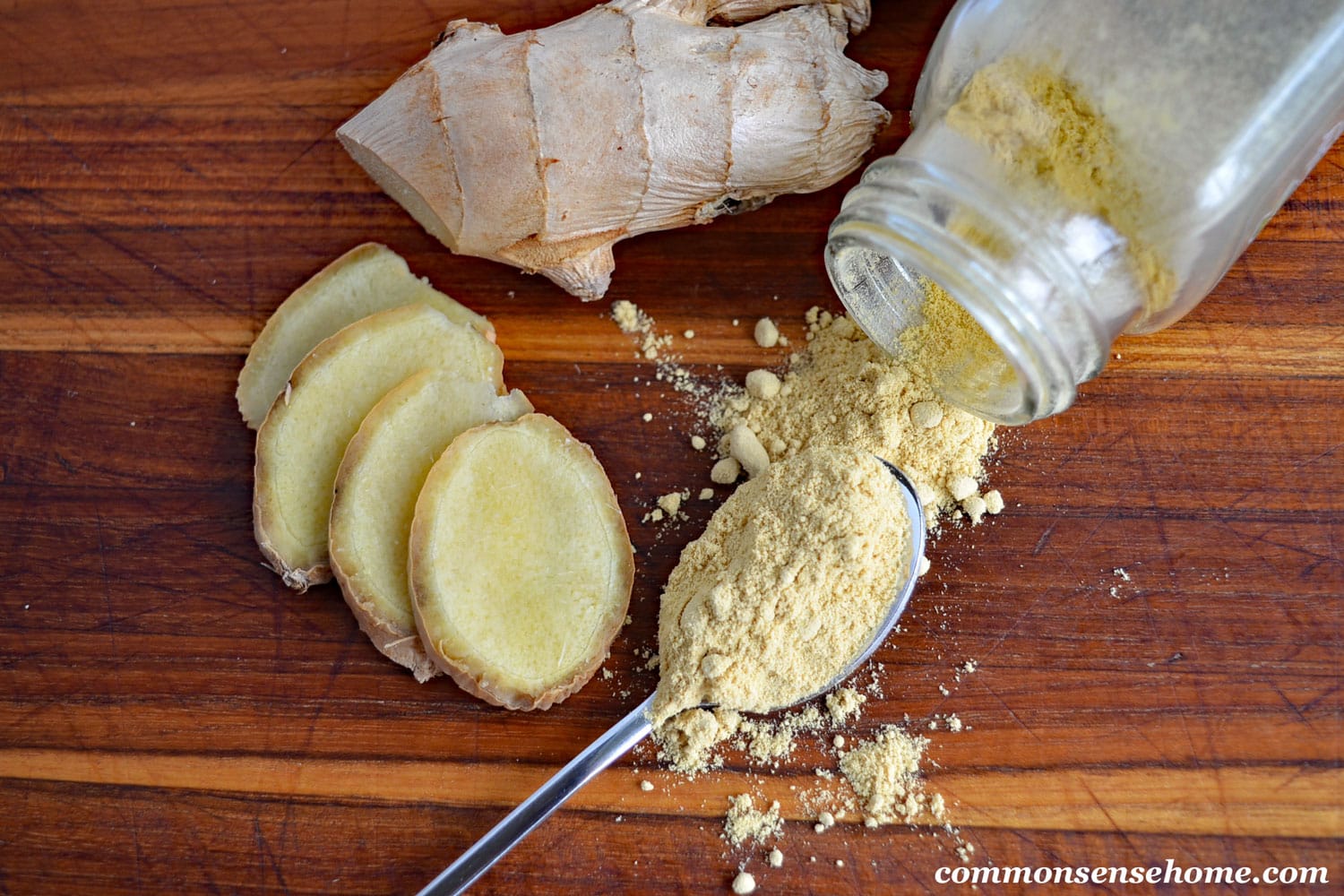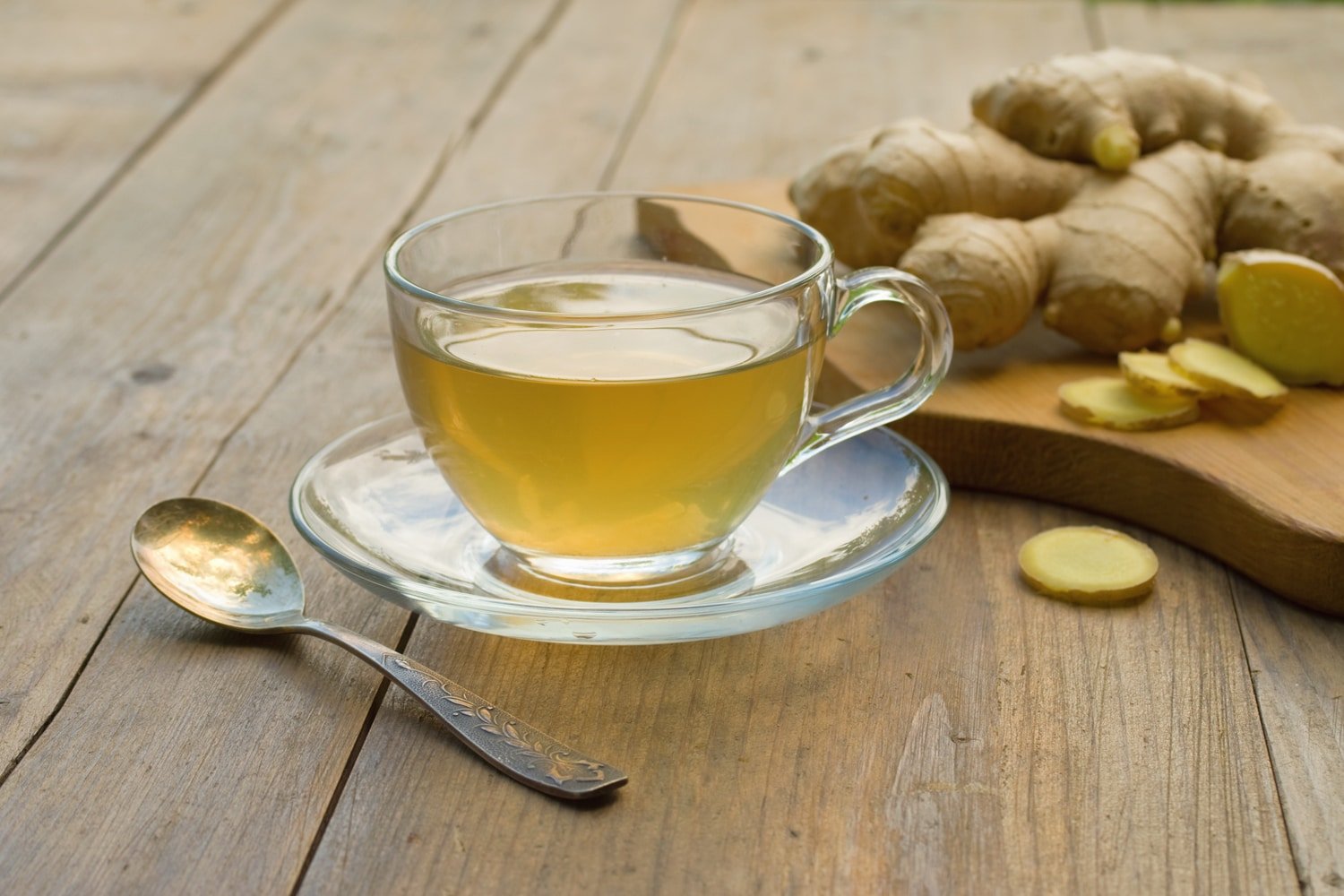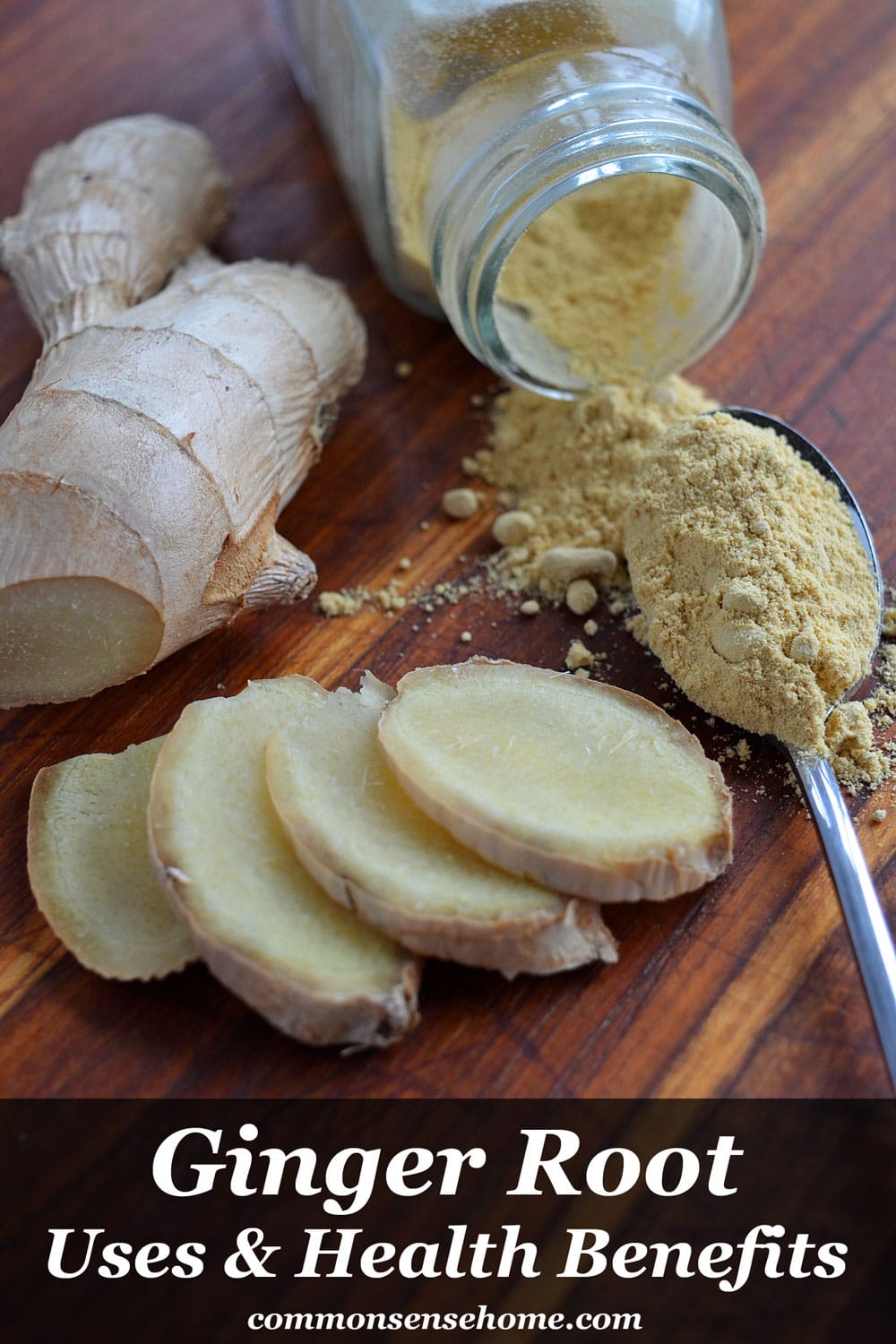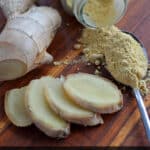Ginger Root Uses & Health Benefits
This post may contain affiliate links. Read my full disclosure here.
Ginger root (Zingiber officinale) is an invaluable herb for the home apothecary. It’s native to South Asia, East Africa, the Caribbean, India, Europe, and is grown in other tropical climates. Let’s take a look at how to use ginger as food and medicine, as well as some contraindications.

Ginger root has a pungent, spicy, sweet taste. It’s used in recipes, chewed fresh, and candied. Medicinally, uses include infusion (tea), syrup, tincture, and topical application as an oil or poultice.
For tinctures, I prefer to use the chopped, dried root. The dried root is a bit more pungent, so for sensitive digestion, use fresh ginger root for your tea.
Ginger Root Uses
Ginger stimulates circulation and energy, which is why it is referred to as a “warming” herb. It supports digestion, immunity, heart health, and even sexual vigor. Ginger is a valuable herb in fighting upper respiratory infections, as it is both antiviral and antimicrobial. It also thins the mucus, and acts as an expectorant.
Ginger is also a diaphoretic (sweat inducing), which means it will effectively cool an overheated, feverish body. Ginger improves digestion, bile secretion, and fat digestion. It helps move food through the digestive tract, which improves gas and irritation.
Ginger supplementation also improves lipid (fat) metabolism, which may help maintain a healthy body weight.
Ginger’s actions are:
- Antiemetic
- Anti-inflammatory
- Antispasmodic
- Antiviral
- Carminative
- Circulatory stimulant
- Radioprotective
- Antimicrobial
Perhaps most notably, compounds in ginger act as an antiemetic, alleviating nausea and vomiting. This makes it effective against motion sickness and morning sickness, as well as chemotherapy, and postoperative induced nausea.
Researchers found that at low concentrations “zingerone”, which is a chemical substance that is produced when ginger is cooked, reduced genetic damage in human lymphocytes. They compared zingerone to the leading drug Amifostine for radiation sickness, and found evidence that the ginger compound was 150 times more powerful and produced no side effects.
Ginger reduces blood pressure, and increases circulation by “thinning” the blood. The increased circulation cools arthritic joints, as the “gingerols” fight against inflammation.
Clinical trials suggest that Zingiber officinale is effective against inflammation from dysmenorrhea, osteoarthritis, rheumatoid arthritis, and musculature discomfort.
Ginger warms and stimulates the pelvic area which makes it effective against menstrual cramps, as well as promoting menstruation, and easing painful ovulation. Ginger also has a long reputation as an aphrodisiac as it is enlivening to the reproductive system for both men and women, which can enhance sexual vigor, and lend support to men who struggle with impotence.
Ways to Use and Dosage
How to use ginger:
- As a food, or ingredient in recipes
- Tea
- Decoction
- Infused honey
- Infused oil
- Poultice
- Ginger Powder
- Tincture
- Syrup
Cooking
It’s safe to use ginger raw, cooked, or dried. Add ginger to stir fries, and seasonal baking such as cookies, cakes, and breads.
Tea
You can add ginger to your herbal tea blends, which will enhance the actions of the other herbs. To make plain ginger tea, add a few teaspoons of fresh (one teaspoon dried) ginger to eight ounces of water. Steep for at least fifteen minutes.

Decoction
Would you like to save this?
To make a decoction, add a few teaspoons of fresh (one teaspoon dried) ginger to eight ounces of water. Cover and boil for at least fifteen minutes. Take as often as three times a day.
Tincture
To make a ginger tincture using the folk or “simplers” method, start with 80 proof vodka, or similar alcohol.
For dry ginger, fill a clean mason jar ¼ or ⅕ of the way with the dry herb. Then fill the rest of the jar with the alcohol, cap and shake. Label with the common name, scientific name, the date, and any other information you desire. Shake daily to help infuse the herb. The tincture will be ready in about six weeks.
For fresh ginger, loosely fill your jar with chopped, or grated ginger. Fill the jar with the alcohol so that it covers the top of the ginger, cap and label. Shake daily for six weeks. The adult dose is about 30 drops, or one dropper full.
Ginger For Wound Healing
Ginger’s anti-inflammatory, antiseptic, and antimicrobial properties make it a very serviceable wound healer. Use ginger infused honey, if it has garlic in it – even better! Simply strain your honey through a cheesecloth, and use the honey directly on the wound.
See “Honey as Medicine” for more information on the benefits of honey.
Health Benefits of Ginger Soaks and Compresses
Ginger’s anti-inflammatory properties make it helpful for sore muscles, strains, sprains and bruises. Ginger pulls blood to the surface, relieving aches and pains.
For soaking, make a strong ginger tea, and soak the affected area for about 15 minutes. You can add cayenne peppers to increase the potency.
To make a poultice, soak a piece of flannel in your strong ginger tea. Wring it slightly, and apply to the area. Warm the tea periodically, since it works best when it is heated.
Try Zingiber officinale for both acute and chronic pain. It is effective against arthritis, back pain, kidney pain, and even toothaches. Use a weaker tea, or discontinue use, if redness or blistering occurs.
Who should not eat ginger root?
Ginger may interact with certain pharmaceutical medications such as Warfarin, and medications for blood sugar, and blood pressure. It is a blood thinner so it could increase the risk of bleeding.
A small amount of ginger is safe for pregnancy nausea, but expecting mothers should avoid large doses. Pregnant women should limit themselves to no more than two grams daily.

Is Ginger Root the same as Wild Ginger?
Unlike wild ginger root (Asarum canadense) which grows in deciduous forests in eastern North America, and up into Canada, Zingiber officinale has smooth, shiny, reedlike stalks that grow out of fleshy, yellow rhizomes. The rhizomes are the part we use for food, and medicine.
Although Asarum canadense (wild ginger) has been used as medicine by Native Americans, and has similar aromatic properties to true ginger, it should not be used as a substitute, because, although similar in properties, it is a different plant.
For more in depth information on herbal remedies, check out the wonderful courses at the Herbal Academy.
Other articles in the series include:
White Willow Bark – Harvesting and Use

This article was written by Sylvia Gunther. Sylvia studied under Rosemary Gladstar and earned the distinction of Traditional Herbalist. She then studied Clinical Herbalism through The Herbal Academy, where she continues her life long exploration of herbs.
Sylvia and her husband live in North Central Indiana. Together they raised six beautiful children.

